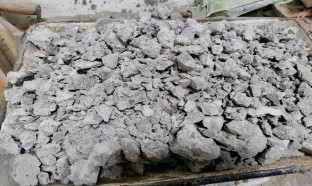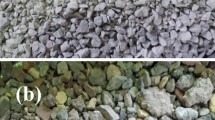Abstract
There is a huge demand for aggregates in the concrete industry and consequently; their alternatives have to be identified to replace the conventional ones. This paper presents a comprehensive study of designed concrete mix with its microstructural analysis focusing on the materials’ impact on interfacial transition zone (ITZ). Recycled concrete aggregates were acquired to replace the natural aggregates. Mixture designs were developed with and without recycled aggregates for M20 and M30 grades of concrete. Mineral supplement, Alccofine has been added at 12% and 15% replacement with cement to enhance the strength and microstructure of concrete. Experimental analysis comprising of mechanical, and durability tests were performed, and compared. Microstructural analysis comprising of X-ray diffraction (XRD), scanning electron microscopy (SEM), and energy dispersive X-ray spectroscopy (EDS) was performed to study the ITZ of the concrete samples. The inclusion of recycled aggregates did not adhere to much strength enhancement, but their combination with Alccofine has raised the compressive strengths. It is observed that the presence of Alccofine in the concrete design has made it less porous, denser in microstructure, and has achieved rapid strength. The microstructural analysis demonstrates a strong relationship between the thickness of ITZ and cement hydration within the samples of Alccofine.

















Similar content being viewed by others
Data availability
The data used to support the findings of this study are included within the article.
References
Allujami HM, Abdulkareem M, Jassam TM, Al-Mansob RA, Ng JL, Ibrahim A (2022) Nanomaterials in recycled aggregates concrete applications: mechanical properties and durability: a review. Cogent Eng. https://doi.org/10.1080/23311916.2022.2122885
Ansari US, Chaudhri IM, Ghuge NP, Phatangre RR (2014) Concrete with alccofine & fly ash an economical & environment friendly approach. Int J Mod Trends Eng Res 2:279–285
ASTM C1202-12 (2012) Standard test method for electrical indication of concrete’s ability to resist chloride ion penetration. Am. Soc. Test. Mater, pp 1–8, https://doi.org/10.1520/C1202-12.2
Bhardwaj B, Kumar P (2017) Waste foundry sand in concrete: a review. Constr Build Mater 156:661–674. https://doi.org/10.1016/j.conbuildmat.2017.09.010
Boobalan SC, Srivatsav VA, Nisath AMT, Babu AP, Gayathri V (2021) A comprehensive review on strength properties for making Alccofine based high performance concrete. Mater Today: Proc 45:4810–4812
Gayathri K, Ravichandran K, Saravanan J (2016) Durability and cementing efficiency of Alccofine in concretes. Int J Eng Res Technol 5:460–467
Hamada HM, Jokhio GA, Al-Attar AA, Yahaya FM, Muthusamy K, Humada AM, Gul Y (2020) The use of palm oil clinker as a sustainable construction material: a review. Cem Concr Compos 106:103447. https://doi.org/10.1016/j.cemconcomp.2019.103447
IS 12269 (1987) 53 grade ordinary Portland cement. Bur. Indian Stand. New Delhi
IS 2386 (Part I)-1963 (1996) Indian Standard Methods of test for aggregates for concrete: deterious materials and organic impurities, VIII reprint April 1996, Bureau of Indian Standard, New Delhi, 110 002
IS 383 (2016) Coarse and fine aggregate for concrete—specification, New Delhi, India
IS 516 (1959) Method of tests for strength of concrete. Bur. Indian Stand. pp 1–30
IS 5816 (1999) Indian standard Splitting tensile strength of concrete—method of test (first revision). Bur. Indian Stand. New Delhi (reaffirme), pp 1–14
IS:10262 (2009) Indian Standard Guidelines for concrete mix design proportioning. Bur. Indian Stand. New Delhi
Lakshmikanth S, Nataraja MC, Supreeth (2022) Performance of high-strength concrete using Alccofine and GGBFS. J Inst Eng (india) Ser A 103(2):567–580
Mani A, Muthukumar S, Sathyanarayanan KS (2023) Use of alccofine 1203 as a sustainable supplementary cementitious material for printable concrete. Mater Today: Proc 93:489–496
Martin GF, Ghooray G, Ho RH, Pindzola RR, Xu XM (1991) Nanotechnology in concrete materials. Dev Brain Res 58:203–213. https://doi.org/10.1016/0165-3806(91)90006-5
Nainwal A, Chauhan A, Bhandari J (2017) Comparison between simple concrete cubes and Alccofine mixed concrete cubes (M20 Grade). Int J Sci Res Educ 5:6857–6871
Patel VA, Parmar A (2022) Influence of cement replacement materials on workability and mechanical properties of high-performance concrete: critical review. In: Proceedings of international conference on “Advancement in Structural & Geotechnical Engineering” ASGE’22, p 72
Reddy AN, Meena T (2018) A study on compressive behavior of ternary blended concrete incorporating Alccofine. Mater Today: Proc 5(5):11356–11363
Reddy GGK, Ramadoss P (2021) Performance evaluation of ultra-high-performance concrete designed with alccofine. Innov Infrastruct Solut 6(1):6
Sachdeva A (2018) Replacement of Portland cement with alccofine: a review. Int J Res Appl Sci Eng Technol 6:1285–1288. https://doi.org/10.22214/ijraset.2018.3200
Sagar B, Sivakumar MVN (2021) Use of Alccofine-1203 in concrete: review on mechanical and durability properties. Int J Sustain Eng 14(6):2060–2073
Sharma D, Sharma S, Goyal A (2016) Utilization of waste foundry slag and Alccofine for developing high strength concrete. Int J Electrochem Sci 11:3190–3205. https://doi.org/10.20964/110403190
Singh R, Nayak D, Pandey A, Kumar R, Kumar V (2022) Effects of recycled fine aggregates on properties of concrete containing natural or recycled coarse aggregates: a comparative study. J Build Eng 45:103442. https://doi.org/10.1016/j.jobe.2021.103442
Srinath BS, Patnaikuni CK, Balaji KVGD, Kumar BS, Manjunatha M (2021) A prospective review of alccofine as supplementary cementitious material. Mater Today: Proc 47:3953–3959
Srinivasulu D, Vaneela D (2018) Experimental study on concrete by partial replacement of cement with fly ash and fine aggregate with recycled plastic granules. Int J Innov Technol Explor Eng 7:20–24
Tangadagi RB, Manjunatha M, Seth D, Preethi S (2021) Role of mineral admixtures on strength and durability of high strength self-compacting concrete: an experimental study. Materialia 18:101144
Tank I, Sharma S, Rattan JSJS (2017) Study on rheological and hardened properties of alccofine and fly ash based high strength self compacting fibrous concrete
Torres A, Bartlett L, Pilgrim C (2017) Effect of foundry waste on the mechanical properties of Portland Cement Concrete. Constr Build Mater 135:674–681. https://doi.org/10.1016/j.conbuildmat.2017.01.028
Upadhyay SP, Jamnu MA (2014) Effect of compressive strength of high performance concrete incorporating Alccofine and fly ash. J Int Acad Res Multidiscip
Yadav KP, Samanta AK (2023) Characterization and development of alccofine based sustainable concrete—a review. Mater Today Proc. https://doi.org/10.1016/j.matpr.2023.05.331
Zabihi SM, Tavakoli HR (2019) Evaluation of monomer ratio on performance of GGBFS-RHA alkali-activated concretes. Constr Build Mater 208:326–332. https://doi.org/10.1016/j.conbuildmat.2019.03.026
Author information
Authors and Affiliations
Contributions
The research work has been guided by Dr. B.K. Vendhan. The experimental work has been carried out by Hariom Khungar. The research paper has been written by Hariom Khungar and some portion of analysis has been done by Nilesh Parmar.
Corresponding author
Ethics declarations
Conflict of interest
The authors declare no competing interests.
Additional information
Publisher's Note
Springer Nature remains neutral with regard to jurisdictional claims in published maps and institutional affiliations.
Rights and permissions
Springer Nature or its licensor (e.g. a society or other partner) holds exclusive rights to this article under a publishing agreement with the author(s) or other rightsholder(s); author self-archiving of the accepted manuscript version of this article is solely governed by the terms of such publishing agreement and applicable law.
About this article
Cite this article
Khungar, H., Kondraivendhan, B. & Parmar, N. Influence of Alccofine on interfacial transition zone of recycled aggregates in concrete. Multiscale and Multidiscip. Model. Exp. and Des. (2024). https://doi.org/10.1007/s41939-024-00434-2
Received:
Accepted:
Published:
DOI: https://doi.org/10.1007/s41939-024-00434-2



